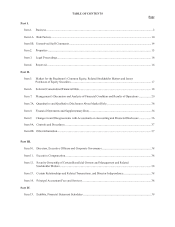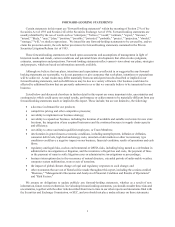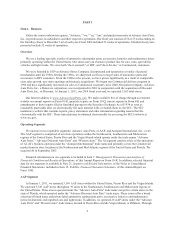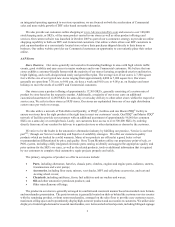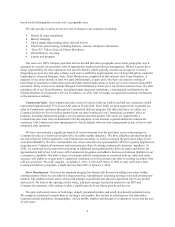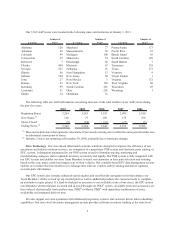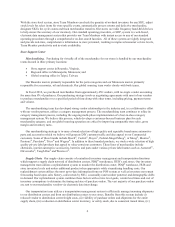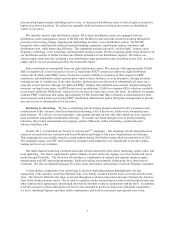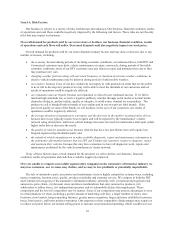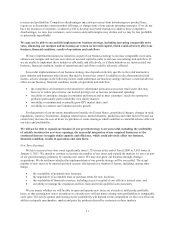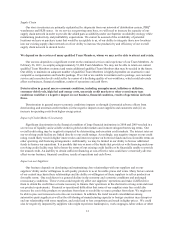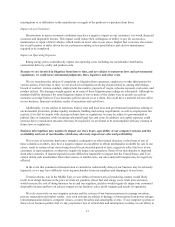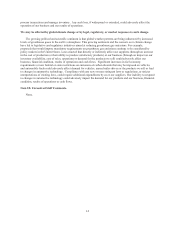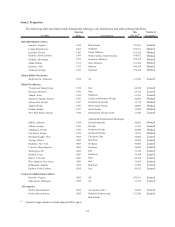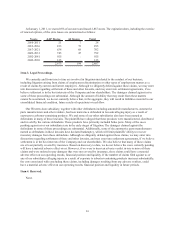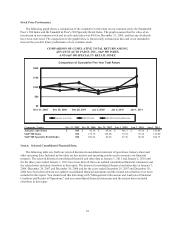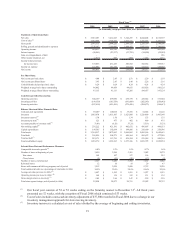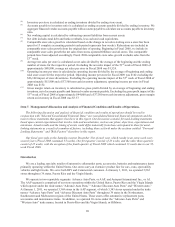Advance Auto Parts 2011 Annual Report Download - page 25
Download and view the complete annual report
Please find page 25 of the 2011 Advance Auto Parts annual report below. You can navigate through the pages in the report by either clicking on the pages listed below, or by using the keyword search tool below to find specific information within the annual report. 10
Item 1A. Risk Factors.
Our business is subject to a variety of risks, both known and unknown. Our business, financial condition, results
of operations and cash flows could be negatively impacted by the following risk factors. These risks are not the only
risks that may impact our business.
If overall demand for products sold by our stores slows or declines, our business, financial condition, results
of operations and cash flows will suffer. Decreased demand could also negatively impact our stock price.
Overall demand for products sold by our stores depends on many factors and may slow or decrease due to any
number of reasons, including:
• the economy, because during periods of declining economic conditions, as mentioned above, both DIY and
Commercial customers may defer vehicle maintenance or repair; conversely, during periods of favorable
economic conditions, more of our DIY customers may pay others to repair and maintain their cars or they
may purchase new cars;
• changing weather patterns along with increased frequency or duration of extreme weather conditions, as
elective vehicle maintenance may be deferred during periods of unfavorable weather;
• our vendors, because if any of our key vendors do not supply us with products on terms that are favorable
to us or fail to develop new products we may not be able to meet the demands of our customers and our
results of operations could be negatively affected;
• our reputation and our brands, because our reputation is critical to our continued success. If we fail to
maintain high standards for, or receive negative publicity whether through social media or normal media
channels relating to, product safety, quality or integrity, it could reduce demand for our products. The
product we sell is branded both in brands of our vendors and in our own private label brands. If the
perceived quality or value of the brands we sell declines, in the eyes of our customers, our results of
operations could be negatively affected;
• the average duration of manufacturer warranties and the decrease in the number of annual miles driven,
because newer cars typically require fewer repairs and will be repaired by the manufacturer’s dealer
network using dealer parts; and lower vehicle mileage decreases the need for maintenance and repair (while
higher miles driven increases the need);
• the quality of vehicles manufactured, because vehicles that have low part failure rates will require less
frequent repairs using aftermarket parts; and
• the refusal of vehicle manufacturers to make available diagnostic, repair and maintenance information to
the automotive aftermarket industry that our DIY and Commercial customers require to diagnose, repair
and maintain their vehicles, because this may force consumers to have all diagnostic work, repairs and
maintenance performed by the vehicle manufacturers’ dealer network.
If any of these factors cause overall demand for the products we sell to decline, our business, financial
condition, results of operations and cash flows could be negatively impacted.
If we are unable to compete successfully against other companies in the automotive aftermarket industry we
may lose customers, our revenues may decline, and we may be less profitable or potentially unprofitable.
The sale of automotive parts, accessories and maintenance items is highly competitive in many ways, including
name recognition, location, price, quality, product availability and customer service. We compete in both the DIY
and Commercial categories of the automotive aftermarket industry, primarily with: (i) national and regional retail
automotive parts chains, (ii) discount stores and mass merchandisers that carry automotive products, (iii)
wholesalers or jobber stores, (iv) independent operators and (v) automobile dealers that supply parts. These
competitors and the level of competition vary by market. Some of our competitors may possess advantages over us
in certain markets we share, including a greater amount of marketing activities, a larger number of stores, store
locations, store layouts, longer operating histories, greater name recognition, larger and more established customer
bases, lower prices, and better product warranties. Our response to these competitive disadvantages may require us
to reduce our prices below our normal selling prices or increase our promotional spending, which would lower our


